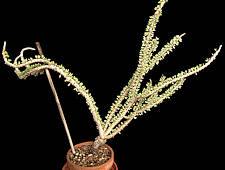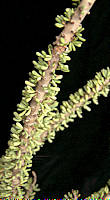|
The Didiereaceae is a small family of 4 genera and around 11 species of unusual spiny-stemmed succulents from Madagascar including the genera Alluaudia, Alluaudiopsis, Decarya and Didierea. Their extreme spinyness mimicks the Cactaceae, and sometimes these succulent shrubs are referred to as "Cacti of the Old World". Their thin leaves during periods of active growth make them easy to distinguish, but the Didiereaceae and Cactaceae are sufficiently closely related that cross-grafting onto e.g. Pereskia stock is possible.
Flowers are small and unisexual with female and male flowers on separate plants. As members of the Order Caryophyllales, Didiereaceae produce betalain pigments, noticable in the pink stigmas and stamens of the flowers.
Recent revisions based on molecular data move the African genus Portulacaria from the Family Portulacaceae. to the Family Didiereaceae Sub-family Portulacarioideae. Further revision expanded Portulacaria by moving the 9 members of the genus Ceraria into it and renaming them.
The East-African Sub-family Calyptrothecoideae with two caudiciform Calyptrotheca species is now also included in the Didiereaceae.
|
|
|
|
Six species of very spiny, columnar, cactus-like succulent shrubs and trees from Madagascar where they grow in spiny forests. The stems produce pairs of deciduous leaves during active growth but the leafless stems are also photosynthetic. Alluaudia are dioecious so male and female plants need to be grown for them to fruit.
|
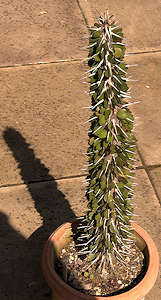
Alluaudia ascendens Drake del Castillo 1903
is a columnar succulent tree up to 45 ft tall. The stem is densely furnished with sharp thorns, in between which pairs of small, green heart-shaped leaves are produced during the growing season. Clusters of yellow-green flowers on long petioles are produced at the ends of the branches.
Native to dry spiny forests Madagascar.
|
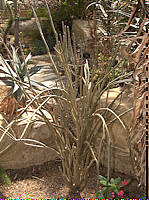 |
Alluaudia dumosa Drake 1903
is a slow-growing spiny shrub or tree up to 25 ft tall with grey-green branching stems. New growth is spiny, but older stems lose their spines. Green rounded leaves are produced adjacent to spines. Flowers are greenish-white with pink stamens and centres, clustered around the ends of the stems. A decoction of the stems is said to have antiseptic properties for use as e.g. mouthwash. The wood can also be used.
Native to dry lowland of Southern Madagascar. As it is drought tolerant, this plant is suitable for dry landscaping in a warm climate.
|
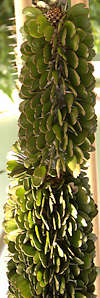 |
Alluaudia montagnacii Rauh 1961
is a columnar tree up to 40 ft tall with vertical branches. The succulent stem is densely furnished with sharp thorns, in between which pairs of oval green leaves are produced during the growing season.
Native to dry spiny forests Madagascar. This species has a very limited range and may be a natural hybrid between A. ascendens and A. procera.
|
|
Two species of very spiny, cactus-like succulent shrubs from Madagascar. The thick stems are furnished with tubercles from which grow groups of 4 or more spines and leaves during the growing season.
|
Didierea trollii Capuron & Raugh 1961
a low, shrub from Madagascar. The spiny, succulent stems initially grow along the ground, bearing small deciduous green leaves when in active growth. Mature stems rise 3-6 ft, producing clusters of greenish-white flowers with pink stamens. Prostrate stems also flower occasionally.
|
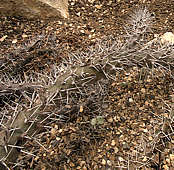 |
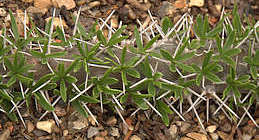 |
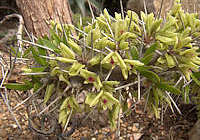 |
|
|
|
Portulacaria Jacquin 1786
Portulacaria is a genus that includes the Southern African succulent tree Portulacaria afra and species formerly in the genus Ceraria. DNA studies have shown the latter to have more affinity with the Family Didiereaceae than with their former placement in the Family Portulacaceae. The 9 species moved from Ceraria are sparsely-branching xerophytic shrubs without spines and with small succulent leaves that help to conserve scarce moisture. The photosynetic stems have papery, peeling bark. These succulent shrubs are native to the Namaqualand region of South Africa and Nambia.
|
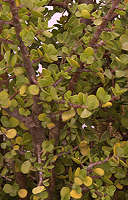
Portulacaria afra Jacquin 1786 (Elephant's Food, Elephant Bush, Porkbush, Spekboom)
is a bushy succulent tree with small, oval, fleshy leaves arranged in alternatively opposite pairs on a glossy red-brown stem without spines. The succulent leaves are edible with a sour flavour and can be chewed or added to stews. The foliage is favoured by elephants and tortoises. Masses of small pink, star-shaped flowers are produced in the Spring.
In South Africa, Portulacaria afra is used as hedging and can be used for bonsai. Cuttings root and grow easily. They make excellent grafting stock for other members of the Family Portulacaceae, especially Ceraria namaquensis. A variegated cultivar Portulacaria afra f. variegata (Rainbow Bush) is available and seems to function as a rooting stock for my Portulacaria namaquensis. Portulacaria afra is a host for the parasitic mistletoe, Viscum crassulae.
As a CAM (Crassualcean Acid Metabolism) plant, Portulacaria afra can absorb large amounts of carbon-dioxide, despite adverse conditions, and has potential to produce biomass for fuel.
|
|
Portulacaria namaquensis Sonder 1862 (Namaqua porkbush)
Syn. Ceraria namaquensis (Sonder) H.Pearson & Stephens 1912
This shrubby plant has tiny gray-green ovoid leaves along its infrequently-branching stems. The succulent leaves may be deciduous in dry conditions but less so in cultivation where they may be retained thoughout the year. It is considered difficult on its own roots and is usually grown grafted on Portulacaria afra. In the Spring, many small pink dioecious flowers with reflexed petals can be produced along the stems.
Fairly widespread in South Africa, especially Namaqualand and into Namibia.
Grafted plants on P. afra rootstock are not difficult to grow, but very slow to get bigger. Remove any suckers from the rootstock or they will outgrow the graft.
|
|
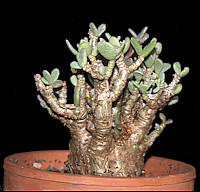 Portulacaria pygmaea Pillans 1928 (pygmy porkbush)
Portulacaria pygmaea Pillans 1928 (pygmy porkbush)
Syn. Ceraria pygmaea (Pillans) G.D. Rowley 1996
This dwarf caudiciform plant has small rounded very succulent gray-green leaves 0.25 to 0.5 in long, on many very short photosynthetic stems arising from a stout, squat caudex with a peeling skin and thickened roots. Both the caudex and fleshy leaves store water against drought. The leaves are long-lived but detach easily. It grows happily on its own roots, albeit very slowly and may produce tiny white to pale pink dioecious flowers.
Native to quartz patches of the Northern Richtersveld of Namaqualand into Namibia. In its habitat the caudex is mostly buried, but is usually grown exposed in cultivation. This self-bonsaiing succulent is not dificult to keep alive but growth is slow.
|
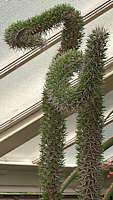 |
Cultivation:
Several members of the Family Didiereaceae are grown as ornamental species but growth of Alluaudia, Didierea and Ceraria tends to be painfully slow. Portulacaria afra is not difficult to cultivate, grows faster than many others in this group and is a good rooting stock. A variegated cultivar P. afra is sometimes seen.
Didiereaceae are hot-house plants and will not tolerate cold, but are otherwise undemanding. As with other leafy succulents, the appearance of leaves informs the grower that more water is required and less when the leaves are shed. Daily misting helps to refresh the plants, mimicking the nightly dews of their habitat.
|










